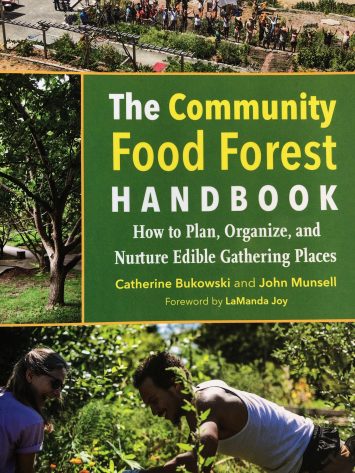The Community Food Forest Handbook: A Review
“The Community Food Forest Handbook: How to Plan, Organize, and Nurture Edible Gathering Places” by Catherine Bukowski and John Munsell is a rare edition to the literatures of permaculture and agroecology: it foregrounds sociocultural dimensions in the context of ecological design. I believe this text will share long-term shelf-space with books like “The Transition Town Handbook” and “The Natural Step for Communities;” its well-organized treatment of community development forces springs from detailed case examples of food forests around the United States. This book will be useful to teachers of ecological design, sustainable community development, and community food systems, as well as anyone wishing to develop a food forest in their community. I have found this text an important addition to my Advanced Permaculture Design course not only for its descriptions of food forest development and succession planning but also for its tangible examples of gift economies in action.
The book is organized so that readers interested in the context, history, and development of food forests can start at the beginning, while those who are working to develop their own community food forest might start in the middle of the book with planning strategies and goal development ideas. The final quarter of the book deals specifically with the relationships at a community scale that are vital to the creation and persistence of food forests, including important discussion about food production as a commons rather than a commodity. Photographs of existing food forests in the United States highlight a number of best practices in design, and an appendix shares vision and mission statements from numerous sites. The concluding chapter of the book summarizes key lessons learned from the studied forests, and next steps for the development of food forests generally.
The text would have benefitted from more figures, charts, and maps to summarize the dense detail presented and make for easy return reference and comparison. It is hoped this book galvanizes further research, and that the literature will continue to expand with a survey of food forests internationally as well as community-level policy resources. Community food forests are still relatively rare in U.S. cities and towns, and this text is a needed summary of existing work plus references to emerging networks and leading organizers. Ongoing work related to this book may be found at www.communityfoodforests.com.











 Clare Hintz is the editor in chief of the Journal of Sustainability Education. Clare has a Ph.D. in Sustainability Education with a focus on Regenerative Agriculture. She has been teaching sustainable agriculture and permaculture since 1998, and has additionally developed curricula for the University of Wisconsin, River Falls, University of Minnesota, Duluth, Northland College, and Prescott College. She is a permaculture consultant in the Midwest, U.S. Her research focuses on arts-informed inquiry, regenerative agriculture, place, and ecofeminism. You can see more of her work at www.elsewherefarm.com.
Clare Hintz is the editor in chief of the Journal of Sustainability Education. Clare has a Ph.D. in Sustainability Education with a focus on Regenerative Agriculture. She has been teaching sustainable agriculture and permaculture since 1998, and has additionally developed curricula for the University of Wisconsin, River Falls, University of Minnesota, Duluth, Northland College, and Prescott College. She is a permaculture consultant in the Midwest, U.S. Her research focuses on arts-informed inquiry, regenerative agriculture, place, and ecofeminism. You can see more of her work at www.elsewherefarm.com. 
